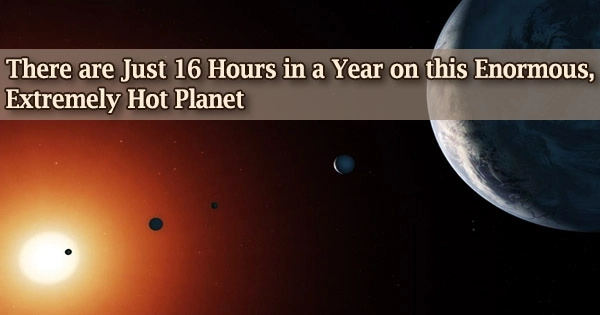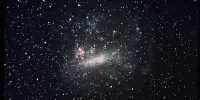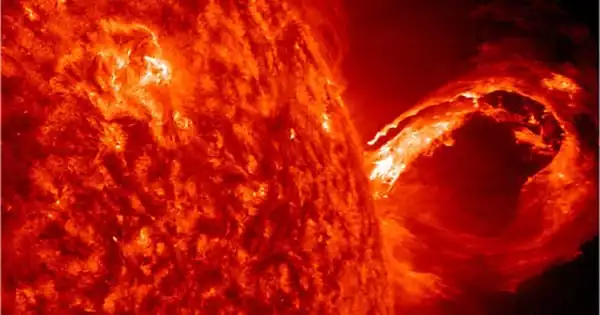More than 4,000 distant worlds, orbiting stars hundreds of light-years from Earth, have been discovered as a result of the search for planets outside of our solar system. These extrasolar planets are a real zoo, ranging from massive gas giants to rocky super-Earths and miniaturized Neptunes.
“Hot Jupiters” are gigantic gas balls that are around the size of our own Jovian planet but that zip around their stars in less than 10 days, as opposed to Jupiter’s plodding, 12-year orbit, and are among the more perplexing planets discovered to date.
Approximately 400 hot Jupiters have been found by scientists so far. One of the largest unanswered questions in planetary science is how exactly these heavy whirlers came to be.
The most extreme ultrahot Jupiters have already been found by scientists, including one that is a gas giant that orbits its star in just 16 hours and has a mass roughly five times that of Jupiter. The planet has the shortest orbit of any gas giant discovered to date.
The planet’s day side is thought to be roughly 3,500 Kelvin, or close to 6,000 degrees Fahrenheit, about as hot as a tiny star because of its incredibly close orbit and proximity to its star. The planet, known as TOI-2109b, is now the second-hottest planet to have been discovered thus far.
Astronomers surmise that TOI-2109b is spiraling into its star, like bathwater going down the drain, based on its features, which is known as “orbital decay.” The planet is expected to spiral toward its star more quickly than other hot Jupiters because to its incredibly brief orbit.
The discovery offers scientists a rare chance to examine how planets behave when they are dragged in and devoured by their star. It was made by NASA’s Transiting Exoplanet Survey Satellite (TESS), a program lead by MIT.
“In one or two years, if we are lucky, we may be able to detect how the planet moves closer to its star,” says Ian Wong, lead author of the discovery, who was a postdoc at MIT during the study and has since moved to NASA Goddard Space Flight Center. “In our lifetime we will not see the planet fall into its star. But give it another 10 million years, and this planet might not be there.”
The discovery, which was made as a consequence of a significant international collaboration involving members of the TESS science team at MIT, was published today in the Astronomical Journal.
From the beginning of exoplanetary science, hot Jupiters have been seen as oddballs. How does a planet as massive and large as Jupiter reach an orbit that is only a few days long? We don’t have anything like this in our solar system, and we see this as an opportunity to study them and help explain their existence.
Avi Shporer
Transit track
A star called TOI-2109, roughly 855 light years from Earth in the southern Hercules constellation, has been under observation by NASA’s TESS spacecraft since May 13, 2020. The star was designated as the 2,109th “TESS Object of Interest” by the mission due to the likelihood that it might be home to an orbiting planet.
The TESS science team examined the measurements of the star’s light taken by the spacecraft over the course of almost a month for transits, or periodic dips in brightness that might be caused by planets passing in front of them and momentarily obstructing a small portion of the star’s light. The star does, in fact, host an object that transits it roughly every 16 hours, according to the TESS data.
Following the team’s announcement to the larger astronomical community, numerous ground-based telescopes continued their observations of the star throughout the course of the following year in a number of frequency bands. The transiting object, dubbed TOI-2109b, was identified as an orbiting planet as a result of these observations and TESS’ initial discovery.
“Everything was consistent with it being a planet, and we realized we had something very interesting and relatively rare,” says study co-author Avi Shporer, a research scientist at MIT’s Kavli Institute for Astrophysics and Space Research.
Day and night
The scientists discovered that TOI-2109b is extraordinarily close to its star, at a distance of roughly 1.5 million miles out, and is about five times as massive as Jupiter, about 35 percent larger, and at various optical and infrared wavelengths. In contrast, Mercury is only about 36 million kilometers from the Sun.
The star of the planet is around 50% bigger and heavier than our Sun. The scientists calculated that TOI-2109b is spiraling into its star at a rate of 10 to 750 milliseconds per year faster than any hot Jupiter yet discovered based on the observed parameters of the system.
The scientists identified TOI-2109b as an ultrahot Jupiter with the shortest orbit of any known gas giant based on the planet’s size and distance from its star. The planet appears to be tidally locked, with a permanent day and night side, like the Moon with regard to the Earth, like the majority of hot Jupiters.
The team was able to observe the planet’s fluctuating brightness as it rotated about its axis from the month-long TESS measurements. Researchers determined that the day side of the planet achieves temperatures of more than 3,500 Kelvin by witnessing it pass behind its star (a phenomenon known as a secondary eclipse) at both optical and infrared wavelengths.
“Meanwhile, the planet’s night side brightness is below the sensitivity of the TESS data, which raises questions about what is really happening there,” Shporer says. “Is the temperature there very cold, or does the planet somehow take heat on the day side and transfer it to the night side? We’re at the beginning of trying to answer this question for these ultrahot Jupiters.”
The Hubble Space Telescope and the soon-to-be-launched James Webb Space Telescope are among the more potent instruments the researchers expect to use in the near future to observe TOI-2109b. More thorough observations might shed light on the circumstances hot Jupiters face as they approach their star.
“Ultrahot Jupiters such as TOI-2109b constitute the most extreme subclass of exoplanet,” Wong says. “We have only just started to understand some of the unique physical and chemical processes that occur in their atmospheres processes that have no analogs in our own solar system.”
Future observations of TOI-2109b may also shed light on the origins of such perplexing systems.
“From the beginning of exoplanetary science, hot Jupiters have been seen as oddballs,” Shporer says. “How does a planet as massive and large as Jupiter reach an orbit that is only a few days long? We don’t have anything like this in our solar system, and we see this as an opportunity to study them and help explain their existence.”
This research was supported, in part, by NASA.
















